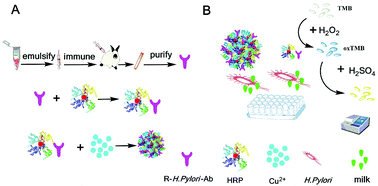The preparation of bifunctional hybrid nano-flowers and their application in the enzyme-linked immunosorbent assay for Helicobacter pylori detection†
Abstract
As the infection by Helicobacter pylori (H. pylori, HP) remains for a lifetime and may induce diseases such as gastric cancer, it is vital to detect and diagnose it. A new non-invasive indirect enzyme-linked immunosorbent assay (iELISA) method based on nano-flowers (NFs) is very advantageous for the sensitive detection of HP. Furthermore, the established iELISA method based on the organic–inorganic bifunctional hybrid nano-flowers including rabbit polyclonal antibody of HP labeled with peroxidase from horseradish (R-HP-Ab–HRP@Cu2+ NFs) showed linearity with HP at a concentration of 0–105 CFU mL−1 (R2 = 0.9997). Moreover, the limit of detection (LOD) reached 50 CFU mL−1, and not only was the detection sensitivity 20 times higher than that based on rabbit polyclonal antibody of HP labeled with peroxidase from horseradish (R-HP-Ab–HRP) but also the stability of R-HP-Ab–HRP in NFs was improved. In addition, the OD450 nm value was still linearly related to the concentration of HP at a range of 0–105 CFU mL−1 (R2 = 0.9952) with a LOD of 50 CFU mL−1 in an artificial saliva system. This study provided a sensitive, low-cost and convenient method for the non-invasive detection of HP.



 Please wait while we load your content...
Please wait while we load your content...